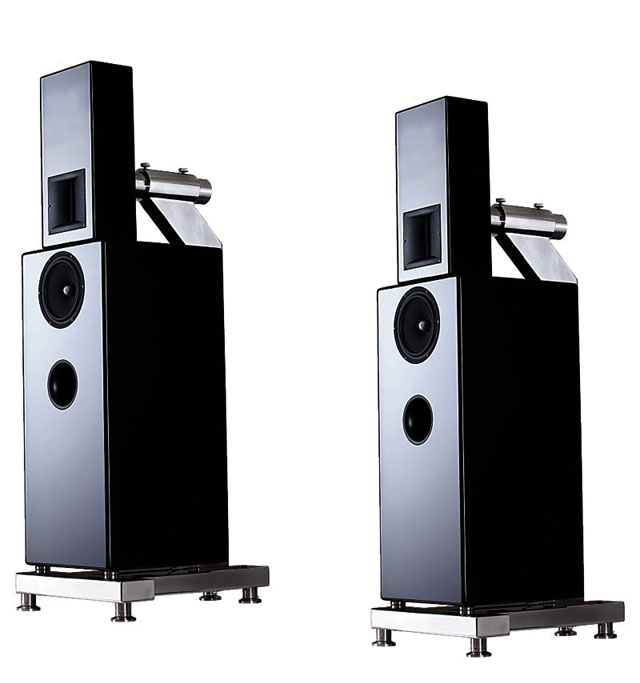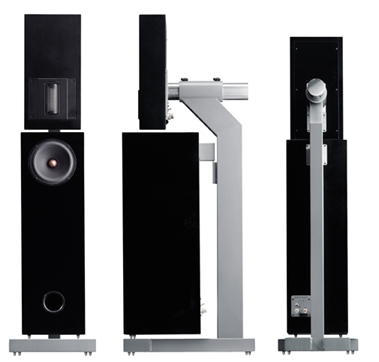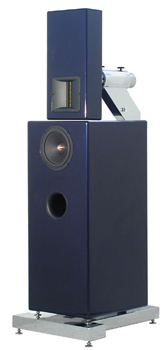From the Archives: Ascendo System M Loudspeaker

The Ascendo System (M)agic Loudspeaker
1. Ma-gic. The art that purports to control or forecast natural events, effects, or forces by invoking the supernatural. 2. The practice of using Ascendo System M loudspeakers to attempt to produce supernatural effects or control events in nature. 3 The exercise of sleight of hand or conjuring for entertainment.
Hailing from Germany, the Ascendo System Z is a new an unusually musical transducer that has swooned nearly all who sat before its mesmerizing gaze. After living with and using Ascendo System Z loudspeaker as a referenced reviewing tool, displacing the mighty Talon Khorus MkII’s, my long time favorite, I hesitated for about one second and purchased them. Of all its world class strengths; soundstaging, image specificity and density along with a super smooth and yet detailed sound I discovered there was one area that I thought could be improved upon (long after I purchased them). That one area was bass impact. To be honest, bass impact is really not something one immediately asks for once you hear a loudspeaker so utterly capable of what audiophiles find imperative to their musical appreciation. But having lived with and becoming spoiled by what I can only describe as bass monsters in the Talon Khorus, I was still finding myself itching for a similar bass from the Ascendos. Sometimes life can make it hard differentiating ones wants from needs. I certainly didn’t need more bass impact. I only wanted it.

Enter the flagship Ascendo System M
What you get in equal portions when you switch to this bigger facsimile is world class dynamics AND musicality altogether. At $40,000 it rests smack dab in the middle of what essentially becomes world class category: capable of reproducing sonics without making any apologies for lack of bass prowess, treble extension, soundstage (depth, height and width, etcetera, etcetera. I still laugh at recommended components costing tens of thousands, given top honors yet attached next to them is low-frequency restricted! At the end of the day one can only sit stupefied.
Lets Get Physical
 The Ascendo System M and Z model, equipped with the same external metal bridge designed to both support the ribbon tweeter right above the bass/mid section and to expunge all unwanted resonances. The only difference between the Systems Z and the M is when you look at the mid/woofer enclosure. Tweeter and midrange drivers (8” SEAS) are identical. What makes the System M more expensive is its substantially bigger woofer than the System Z thanks to an 11” Eton woofer hidden inside its belly versus the smaller 8” housed inside the System Z. This gives the System Z a more slender look, making it more of an eye catcher and thus more WAF friendly.
The Ascendo System M and Z model, equipped with the same external metal bridge designed to both support the ribbon tweeter right above the bass/mid section and to expunge all unwanted resonances. The only difference between the Systems Z and the M is when you look at the mid/woofer enclosure. Tweeter and midrange drivers (8” SEAS) are identical. What makes the System M more expensive is its substantially bigger woofer than the System Z thanks to an 11” Eton woofer hidden inside its belly versus the smaller 8” housed inside the System Z. This gives the System Z a more slender look, making it more of an eye catcher and thus more WAF friendly.
In terms of sensitivity, there are differences. The nominal impedance of the System M, for example, increases to a (specified) 8 ohms compared to the System Z’s lesser rated 5 ohm tap. Sensitivity can also be critical depending on the amplifier used. The System M’s sensitivity is a respectable 88 dB (2.83 V/1m) compared to the System Z’s relatively low 87 dB rating. Located right under each midrange driver are the vent ports and again the System M sports a noticeably larger (5 1/2” diameter) port, compared to the System Z’s 4”. Both loudspeakers boasts the same crossover employing Ascendo’s unique S.A.S.B. low-frequency drive unit (or dynamic current-damped woofer and semisymmetrical bandpass) technology. [Stromdynamisch, the German term for current-damped, allows for the 8″ SEAS Excel paper cone midrange, housed in a small dedicated sealed box, to remain electrically damped and matched in impedance with the internally hidden 11” bass driver]. On the rear of the mid/bass enclosure of both loudspeakers are the variable toggle switch between VD-H (Verstärkerdämpfung hoch) and VD-N (Verstärkerdämpfung niedrig). Switching between settings will affect the speaker’s sensitivity in accordance to the damping factor of amplifier used (i.e. high damping amplifier = VD-H, low damping = VD-N which is normal). As with the System Z, I kept and ultimately preferred the normal setting and for the life of me could hardly tell you what the differences were when I switched to the VD-H setting. I have a sneaky suspicion it doesn’t matter as much using digital amps and hybrids such as the Bel Canto, Acoustic Reality and Chateau Research.
In terms of hookup, again both speakers are equipped with same WBT binding posts for tweeter and mid/bass. Bi-wiring is mandatory while bi-amping is optional. Physically, aside from the larger mid/bass section of the System M, it would be difficult, if not impossible, at a glance to tell both loudspeakers apart. So, then I ask, why invest in the bigger System M?

Don’t Disturb This Groove
The Ascendo System M simply sounds bigger and in my humble opinion, in part to its larger woofer and greater handling sensitivity, better. The TacT 2150 amplifiers sound better driving the larger System M than it did on the smaller but more demanding System Zs. Don’t get the impression they sounded strained on the System Z because they did not. But there was certainly more ease as well as effortlessness when strapped to this larger sibling.
When I listened to the opening of Dance of the Seven Veils from Salome from the Exotic Dances CD (Reference Recording RR71CD), I knew immediately that the System M possessed a bass that was both deeper and possessed more low-end impact. By virtue of these strengths I got the combined benefit of a greater (perceived) three-dimensionality in the lower regions as well. Three-dimensional low end? When your spider senses detect something like that you know you’ve got something special going on.
Jacky Terrasson’s funky smooth jazz remake of Stevie Wonder’s Isn’t She Lovely from his Smile CD (Bluenote 7243540668) serves as a near perfect illustration of the deep and three dimensional bass. Bassist Sean Smith does a worthy job of handling tempo with his unique playing style while Terrasson tickles the ivories in his own very inimitable way. Overall, I like they way they ultimately sound together and the mixing of this disc was also excellently executed which makes this disc a Must Getz (the new title of our recommended CDs). Three dimensional bass is not some figment of a warped reality but the true measure of what is possible when engineering and science are joined in a firm handshake. I think there was a lot of handshaking goings on when you consider the driver integration network of the Ascendo three drivers that sounds flawless to my ears and the ability of TacT digital circuitry to weave, 100% digitally speaking, through both its room correction preamp to the last possible stop for D/A conversion—before the speaker taps inside of the 2150 amplifiers—before it renders itself analogue. In theoretical terms, this is supposed to be the best of what is possible via the digital approach. And to my ears it very well may be.
Dare to Compare
Greg Petan owns the Talon Firebird and his most recent review tells of his admiration for the make, feel and sonic character of this most audacious loudspeaker. Greg and I are not just audiophiles who write for the same rag, but two friends who value each other’s opinions and attitudes. It is with this in mind that I say the Talon Firebird is an awesome loudspeaker that will dazzle anyone that’s wealthy enough to afford them and all the ancillary equipment needed to make them sing. Ditto the Ascendo. At $32k, ($40K with the Diamond tweeter) the Firebird isn’t even remotely affordable. Sadly, though it seems more loudspeakers today are priced in this range. I mention ancillary equipment because I believe that both these speakers will pick up on lesser components flaws like radar so fine equipment with very high synergistic characteristics become a must. [Far too often super-heavyweight systems sound bad because someone went out and bought all highly touted products without ever once considering whether they’d work together.]
Both Greg and I have system that are very different so my impressions are based only on what I heard when I’m over for a listening session. I like the Talon Firebirds. I like them a lot more in Greg’s setup. I think they do exactly what Greg finely illustrates in his review. The Firebirds possess the incredible ability to sound like live instruments are in the room which is something I’ve always craved and tried to recreate in my own listening room. Greg’s room, which is humongous, allows him certain privileges that my relatively quaint setup (17’ by 21’ with an 8’ ceiling) simply cannot.
Quaint does have its advantages when it comes to intimacy. The ability to feel as if you’re at one with the music is more apparent due to my setup being a strictly dedicated one with only a pair of windows keeping the world out. Everything is quieter and closer than at Greg’s so the ability to get lost into the music is going to be easier in a dedicated setup. This gives the appearance of the System M possessing more resolution which is something Greg and I both spoke of. The Firebirds are too big for my room I think. They’re personality isn’t one of subtlety. They want to sing and you probably are going to need the space to let them do just that. The Ascendo are much more laid back sounding due in part to its ribbon tweeter. The System M sound is much more reminiscent of the planar approach than the dynamic one. As a result the sound is unusually relaxed back but at the same time alive. This comes as a big plus in a room the size of mine because the System M’s very character is relaxed, thus not too up close and personal. They literally make my room sound bigger than their true physical size. Hard to explain, but easy to hear.
The Ascendo, on the other hand, could not keep up with the insanely high levels of playback as the Firebirds. Both play louder than they should ever be required to. But the Gryphon Encore amplifier, rated at something like 500 watts per side, driving the Firebirds is something to behold. They personify the meaning “driving” a loudspeaker.
Both these loudspeakers will delight the respective owner with hours of listening pleasure. The Ascendo is not very well known around these parts while the Talon has taken a stronghold in the past couple of years. My hope is that Ascendo will develop into these regions with a strong marketing approach. Their design team possesses the obvious expertise to make loudspeakers throughout their line from the smallest to the largest that all own that signature Ascendo sound: Warm, relaxed and utterly involving without the slightest hint of distortions. Most recently the Ascendo C5 loudspeakers arrived for review and amazingly, without implementation of a ribbon tweeter, this loudspeakers sound exactly like an Ascendo…minus a couple of lower octaves.
If I had to choose one I would have to go with my heart over my head and choose Ascendo for its ability to remain unfazed and relaxed no matter the source. Add to that, a ribbon tweeter which has to be one of the best high-frequency transducers made today.
Hey, $40,000 is a lot of dough for anything much less a loudspeaker! That was the required down payment on my house. Why, for that amount of bread I could go on a world cruise and take the family…and a couple of relatives. But this is the high-end whose very name bespeaks of grandeur, pomposity and very large amounts of paper. The System M has been appointed high-end in the truest sense of the word by virtually everyone who has heard it.
Granted, the System M isn’t going to fit most decors without the exception of the audiophile who finds the look of this most unusual loudspeaker as attractive as I do. Mine is in a dedicated room so I don’t have to worry about that. But there’s no question to the Ascendo M being an exceptionally domineering of ones living quarters. In terms of performance the Ascendo System M resides as the most musically satisfying loudspeakers to have graced my listening room. It hasn’t skipped a beat no matter the musical venue, electronics or digital format. As a matter of fact, the Ascendo System M seems to crave high resolution devices. Case in point: Alex Paychev’s modified Philips 1000 SACD player is a case in point. Playing SACD’s through this machine opened greater possibilities for both SACD as well as what this very capable loudspeaker is MORE capable of. Certainly there’s going to be something to replace the Ascendos as technology continues to move forward. But I must state that this is one that may go down for the ages as the Infinity RS1B’s, the Maggie Tympanies’, and the Quad ESL’s have. The Ascendo System M certainly has earned my highest accolades.


clement perry
Stereo Times Masthead
Publisher/Founder
Clement Perry
Editor
Dave Thomas
Senior Editors
Frank Alles, Mike Girardi, Key Kim, Russell Lichter, Terry London, Moreno Mitchell, Paul Szabady, Bill Wells, Mike Wright, Stephen Yan, and Rob Dockery
Current Contributors
David Abramson, Tim Barrall, Dave Allison, Ron Cook, Lewis Dardick, Dan Secula, Don Shaulis, Greg Simmons, Eric Teh, Greg Voth, Richard Willie, Ed Van Winkle, and Rob Dockery
Music Reviewers:
Carlos Sanchez, John Jonczyk, John Sprung and Russell Lichter
Site Management Clement Perry
Ad Designer: Martin Perry





Be the first to comment on: From the Archives: Ascendo System M Loudspeaker